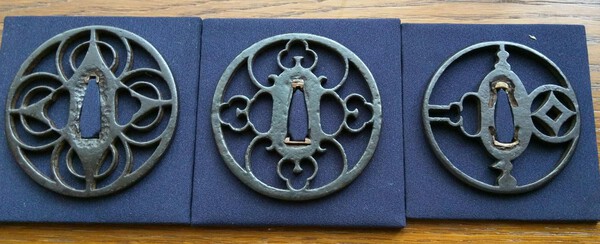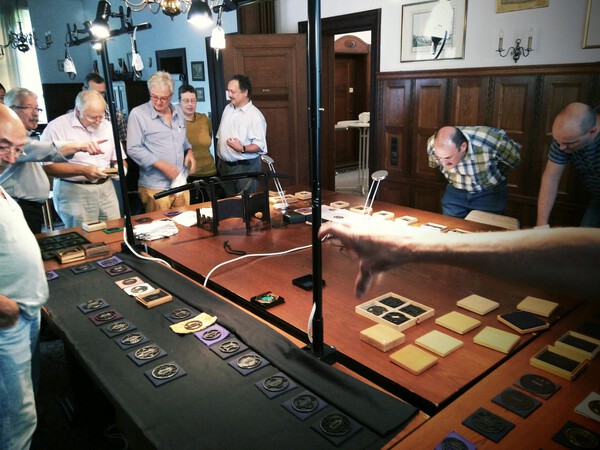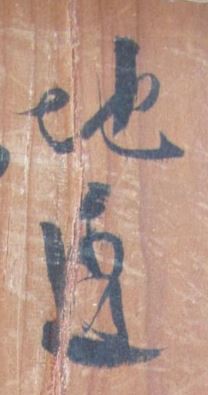-
Posts
1,082 -
Joined
-
Last visited
-
Days Won
5
Everything posted by DirkO
-

Bizen Kozori Moriyasu O-Tanto, Nambokucho, Cheap
DirkO replied to Marius's topic in For Sale or Trade
Very very tempted. Not a lot is known about Kozori school, they're an undervalued/underappreciated lot. They made some really good pieces. -
Hi Alan, Indeed, Miyamoto Kanenori and Gassan Sadakazu received their title "Teishitsu Gigei-in" (帝室 技芸員) in 1906. I can't see the whole date on the picture... Just ju and go, so what comes before that? But reading the reviews on Amazon from some of our members and then this, I think this book was rushed to publication.
-
Arnold makes a very strong and logical point, so I'll adjust my view ???? The motto of the round table:adopt, adapt, improve!
-
Congrats on the new expansion, very worthwhile tsuba indeed! However, maybe you should rename it to High Level Kodogu or something similar? Adding a price could be somewhat confrontational to potential buyers. Just my personal opinion.
-
Just one more: Gustav Jacoby wrote in his "Japanische Schwertzieraten: Beschreibung Einer Kunstgeschichtlich Geordneten" Tokujo, der Sohn des Kojo, arbeitet weiter im Sinne des Vaters, doch ist sein Stil insofern verschieden, als er meist seine Reliefs sch"rfer und h"her geschnitten hat. Gern benutzt er bei seinen Arbeiten die Goldplattierung mit Durchreibung, womit er sehr interessante Effekte zu erzielen wei". Als erster verwendet er auch das Kupfer als Einlage und nach Ausspruch von Kennern auch das Shibuichi. If my German is still up to scratch, it says that "He was the first used copper as a deposit, and according to connoisseurs also shibuichi" - his sources will have been the same as Mosle's. Pity he doesn't go further into this.
-
And there's this (written by Alexander Mosle - so maybe his collection might hold pieces with shibuichi from Tokujo? - don't have the Mosle book) http://www.shibuiswords.com/gotoshirobei.htm "The Author mentioned orikami. These originated with Tokujo, who, in fact, was the first to certify the work of his predecessor and sign them with their names, as well as being the first Goto to use Shibuichi." And here's an attributed Tokujo piece: http://blog.goo.ne.jp/tsuba_001/e/e1c2dbd9df524b49621daaa8ba938a5a
-
The description of kuro shibuichi also comes from Ito's book, - the Nishigaki volume (page 28, annotation 23 at the bottom in the translation by Markus)
-
-
How about Kuro Shibuichi? "This is a sort of shibuichi (literally „black/dark shibuichi“), where the copper is added additionally with arsenic, to achieve a more darker grey wich sometimes can also get a slightly green colouring. " Was used early throughout several Higo schools. In Ito's Nishigaki book there's also mention of a handwriting by Kanshiro II (1639-1717) from his study period with Goto Teijo (approx. 1653-1663) (. This also mentions Shibuichi. Looking at the actual working time for Kanshiro the 2nd, the time when he studied with Goto Teijo well predates the 1700's. However if it was made late in his active career, it might be later than your earliest date.
-
Yep, I think the incense burner idea is better, the similarities are far greater.
-
-
Bizen Nambokucho at first sight - after some investigation, I'll go with Kanenaga.
-

What Is Happening To Nihonto Message Board?
DirkO replied to Peter Bleed's topic in General Nihonto Related Discussion
Although the British museum and Tourist info desk are free - someone is paying for them. It's a free service for you, but in the background they get paid to provide whatever service they give out. Yes, this forum should be welcoming to new people, and it is. But not for the people who want to turn a quick profit. It's a free forum, and that being said, it's a "take it or leave it" approach. If people don't like the advice given here, or the tone of the replies, they can always try elsewhere. However they would be hard pressed to find the info provided here. Seeing it's a free forum, it comes with a free 'attitude' as well. You have to take the rough with the smooth. PS: Guido probably forgot more about nihonto than I will ever know - we should be thankfull for any help he provides. Because the real specialists are very scarce on this forum, and anyone willing to share their knowledge should be applauded and not commented upon because the tone of the reply wasn't to their liking. -
The meeting was well attended with around 20 members. It started off with a sublime explanation by Prof. Kremers in both German and English (which was well received by us foreigners, although most of us understand German to a certain extent). They were arranged by age and as such provided a logical and easy to follow structure. Prof. Eckhard explained using examples how these tsuba followed function over the different periods in time and how some schools like Kyo-Sukashi didn’t. All the usual suspects for sukashi tsuba were there: Ko-Tosho, Ko-Katchushi, Kyo-Sukashi, Kanayama, Owari, Akasaka,…. Even a Kamakurabori tsuba that was relevant to the story. There were over 50 very fine examples. On top of that we were priviledged to see a Juyo Tensho Koshirae, published in various books (eg. Selected Fine Japanese Swords from European N.B.T.H.K. Collections by NBTHK EB and the Solingen Museum). Besides sukashi tsuba, there were also very fine Ko-Kinko works present. A few of which you never would have guessed were KoKinko, but rather late Kinko due to their immaculate state and elaborate details, quite impressive. After the tsuba part, there was also an interesting presentation by Mr Supper about gold mining during the Tokugawa period and these kind of circumstantial items do provide us with a better understanding of the importance and availability of gold during that time, which of course reflects in the production of kodogu in that period.
-
Very true, just as Hakogake and Wakazashi - it should be shirasaya!
-
I was thinking ji-sukashi as well, Thomas, but the kanji doesn't seem to fit - although it could just be really stylized
-
maru? sukashi 丸透 (not sure about first kanji) The lid seems to be by another person, maybe a previous collector (it also states similar things as mumei nanban,....)
-
-
nadekaku gata 撫角形 (edited, first thought I'd knew it, but need to search better) (re edit - found it!!!) Tetsu ji (iron based): 鐡地 Showa 昭和 I'll see if I can find more....
-

Recommended Reading For Beginners
DirkO replied to Ryan's topic in General Nihonto Related Discussion
Hi Ryan, In the FAQ when you scroll down, there is a bit about buying your first sword and also recommended reading. -
So are these: http://nihontou.jp/choice03/toukenkobugu/tantou/069/00.html http://nihontou.jp/choice03/toukenkobugu/tantou/099/00.html I think a ken is a straight blade with a double cutting edge. I'm not so sure it has to be diamond shaped Ken (剣): Usually a tanto or wakizashi length religious or ceremonial blade, with a gentle leaf shape and point, but some may be larger and can also refer to old pre-curve types of swords as above. Symmetrical and double edged.
-
It's not an Omi-yari, that term is only used for yari with a considerable nagasa. I actually do believe it's a Ken, the nakago is tapering too much and it's not square enough for it to be a pole weapon.
-
Pertinent question - where do you go from here as a collector? Stop collecting alltogether? Try to improve the Gokaden? Start with tsuba? No more thrill of the chase for you, Jean?
-

Nihon No Bi: Nihonto (The Japanese Sword)
DirkO replied to Paul Martin's topic in General Nihonto Related Discussion
http://www.cdjapan.co.jp/product/NEOBK-1829538 seems fairly straightforward. Incl EMS shipping the book would be around 53€ if I bought 10 copies. Depending on which shipping option you take, it varies between 49 and 70€ for a single copy. -
Stunning collection! Love the sugata of the Tametsugu, looks very healthy....












